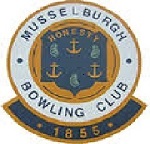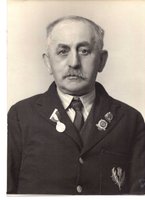THE MUSSELBURGH BOWLING CLUB
History of the Musselburgh Bowling Club
Compiled by David McMillan for the 150th Anniversary Commemorative Booklet in 2005
As an incomer to the Musselburgh and a relatively new member of the club I would like to record my thanks to all of the members who have helped me with this update especially Walter Philip and John Downie Snr.
The last fifty years have seen amazing changes not only in the sport of bowling but in the world in general. Which of our predecessors in 1955 could have envisaged satellite television, cash machines, internet shopping, holidays in Mexico or footballers earning £130,000 a week? Which of them would have thought that in 2005 clubs they knew well would be struggling to attract new members and, in some cases, struggling to survie.
In the wake of of our very successful cenetenary celebrations in 1955 it was fitting that the club Champion in 1956 should be John W Love who had, of course, been our cenetenary President. The post-centenary momemtum was, however, short-lived since it was twelve more years before he managed to triumph again! JW went on to be President of the Midlothian Bowling Association and, in 1977, Scottish Bowling Association President and is, without doubt, one of the most significant figures in the history of The Musselburgh Bowling Club. He worked tirelessly for the club during his life and left a cash legacy without which this club would look quite different than it does today; more of this later.
1957 saw another stalwart of the club, Walter Philip, take the Championship and, like his predecessor go on to be one of the most influential members of the last fifty years. In a sort of reverse of JW Love's pattern, Walter had to do two years as President in 1967 and 68 before winning the Championship again in 1970, thirteen years after his first win.
Walter has Musselburgh Bowling Club in his blood and is very proud that his father and grandfather take the Philip connection back to the early years of the 20th Century. Walter has great respect for the traditions of the Club and, while he is sceptical about the perceived exclusive image of the early days -
"ye had tae be a director or a councillor tae get in"
he is fiercely protective of the respectability of the Club and the fact that its members are expected to behave like gentlemen. He remembers the prominent position of the 'swear box' in the old clubhouse which was only for mild words. Anything stronger and the offender was in trouble with his fellow members never mind the Council.
It is also evident from conversations with Walter and other long standing members that the objectives of the Club were crystal clear and well understood by all. Musselburgh Bowling Club was just that - a bowling club. No social members, no ambitions to host profit-making social events; no pretensions regarding plush surroundings; no telephone. As long as the Club maintained the bowling facilities, provided refreshment and kept it head above water nobody asked for more. After a member took a heart attack in the clubhouse, and subsequently died, it was decided to consider a telephone but it was three years after that tragic event before it was finally installed!
At the time of the Centenary club tours were relatively uncommon and Musselburgh's inaugural tour did not tale place until 1958. After much planning and preparation, twenty - sixteen bowlers and four wives (honestly) boarded the bus for a week's touring based in Llandrindrod Wells, a spa town in Wales. The cost of the tour, including transport, hotel, meals and miniatures to give to opponents was £27 per head.
Their Welsh hosts, dressed in blazers and whites, were surprised to greet the Musselburgh bowlers dressed in lounge suit; a point that was remarked upon by all of their opponents that week. At the end of a very enjoyable week it was decided that blazers and whites would be mandatory dress code. This became common among touring teams in the sixties and seventies and led to the contemporary concept of club dress, the ubiquitous blazer and flannels introduced in the eighties.
There were eleven one week tours in all, in Wales, Ireland and England with only the final one in 1978, being in Scotland at Portsoy. It is worth recounting the costs involved in those pioneering days, for instance Dublin in 1962, return flight from Turnhouse £4.10s (£4.50p today) total cost under £30. Compared with these prices the Portsoy tour in 1978 cost around £90 which was deemed to be too expensive and week-long tours were to give way to the more affordable (sic) week-end versions we know today. Another innovation of the last fifty years in The Musselburgh Bowling Club has been trophies for our competitions. At the time of our Centenary the Championship Medal has been lost in a fire along with the Cochrane Cup. The latter having been salvaged and a new (smaller) version created for the Handicap Competition in 1951.
Since then trophies have been donated for all of our competitions and many skilled bowlers have 'held them aloft'. The WS Lowe Trophy for Scottish Pairs was donated by his widow in 1958. In 1970 WF Gibson, the President, donated a trophy for the two bowl open singles and in 1978 ghe family of W Wilson donated a rosebowl for the club three bowl singles. In the same year the McVicar Triples Trophy was presented to the club.
The ultimate prize is, of course, the Championship and this trophy was presented by the Philip family in 1969. Over the past fifty years, as before, the Championship has been keenly contested and several members have particularly distinguished themselves. Bobby Ross, the wandering minstrel, a three-times winner in 1974, '76 and '78. Billy 'maestro' Rankin (others tell the truth) has four wins to his name and has the only hat-trick of the last fifty years in 1986, '87 and '88 and only the second one in the club's history. Perhaps the most remarkable feat, however, is that of Jimmy Neilson who has amassed five Championship wins over an eighteen-year period between 1979 and 1997 and still going strong!
The Club has also had great success when 'gaun oot' in competitions and our Honours Board does us proud. Since the centenary we have had success in the Elibank Trophy in 1964, '74 and '76 ad the Riding of the Marches in 1974.
We have been spectacularly successful in the Cruden Trophy which was presented by that firm in 1967, at the behest of our now Honorary Vice President Bob Arthur, to be contested among seven local clubs. Musselburgh has triumphed eleven times through Bobby Ross, John Downie Snr., Sep McAlpine, George Langlands, Jimmy Neilson, Billy Rankin (twice), Kenny Ross (thrice) and Sandy Knight.
The Hope Pairs victory of 1980 was especially memorable because of Bob Arthur's partner Alec Grieve who was one of the great characters of The Musselburgh Bowling Club (see Hall of Fame). We have also enjoyed success in the Rosebery in 1977, '83, '95, '99 and 2004, the Midlothian Trophy in 1998, '99 and 2002 and the Douglas Trophy in 2000 and 2003. This year we were proud to to represent Midlothian in the Top Ten competition and we congratulate Jocky Miller and his team for their achievement.
The last fifty years have also seen the birth of the Esk League (1967) and competitive bowling on Friday nights. The Club now has three teams in the first, third and fifth divisions of the league and, home or away, it makes for a lively night in the clubhouse from 9:30pm onwards. The league teams have had various successes since 1967 and the first team are invariably challenging for the top division title.
Off the green, the greatest change has been in our premises with our locker/committee room being completed in 2001 and the clubhouse refurbished in 2002 during the Presidencies of Jim Montgomery and Ward Bannerman respectively.
As mentioned previously, JW Love left a generous bequest to the Club which largely paid for the locker room and which the members are eternally grateful. Many members gave of their time and effort during these projects but I trust no one will be offended if Ward Banneramn and our ex-Match Secretary Jim Hogg get a special mention.
The clubhouse refurbishment required a bank loan which the members approved in the hope that the new clubhouse would generate generate significantly higher income than previously. Sadly, although we have had several successful social events, this has not been the case. The last two years have not been the most financially stable in the Club's history and we are grateful to members like Brian Martin and Jim Little for their generosity. At the time of writing, thankfully, the financial situation has improved and we can enjoy our celebrations confident of a bright future.
Gentlemen, enjoy the week and here's to the next fifty !
David McMillan
Closing of green - 1911
Prior to moving to Church Lane in 1911, the Club was located in Inveresk Road on the site of what is now Tesco Supermarket garage and car park. The tenement flats in the background from Mall Avenue (Riverside Bar) to the Health Centre are still inhabited and the location of the old green can be easily established.
The Club was relocated to accommodate the expansion to Brunton's Wire Mill which was demolished in the 1980's.
W S Lowe - winner of the Club Championship a record eight times in 1914, 1917, 1919, 1923, 1929, 1932, 1941 and 1947.
Scottish Internationalist and Skip of Scottish Rink in Empire Games Competition.


